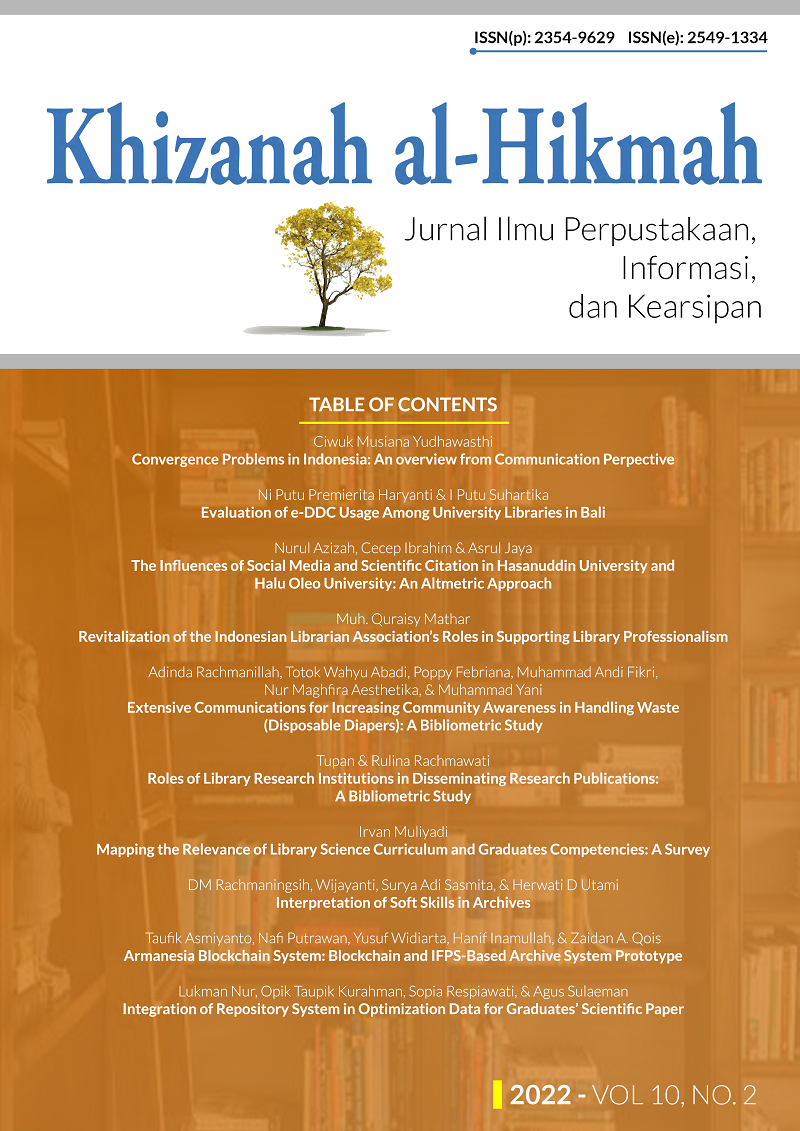Evaluation of e-DDC Usage Among University Libraries in Bali
Abstract
This study examined how librarians at university libraries in Bali used e-DDC. This objective of the study was to ascertain how often e-DDC is used among university libraries and what factors affect that utilization. This study used a descriptive quantitative approach. All members of the library staff or librarians who had utilized e-DDC at university libraries in Bali made up the population and samples used in this study. Total sampling was the chosen sample method. The data were obtained through questionnaires, observations, and interviews. The findings of this study demonstrated that the library personnel preferred using printed DDC over electronic ones. As a result, they do not profit fully from using e-DDC. This was due to the fact that the information in printed DDC is more comprehensive than that in electronic form, making e-DDC utilization less than ideal. External factors like user training, accessibility, term clarity, and convenience of use affected how e-DDC was used. The DDC system must be re-maximized (upgraded) as a result, and the librarian or other library personnel must also be more receptive and adaptable to the current system in the library. The main purpose of using e-DDC is to make it simpler for users to find the needed classification numbers and to improve the processing section's unit.
Downloads
References
Alamsyah, F. (2017). Analisis Sistem Klasifikasi Bahan Pustaka di Perpustakaan Jurusan Ortotik Prostetik Politeknik Kesehatan Kementerian Kesehatan Jakarta I. Skripsi, 119.
Arai, S., & Tsuji, K. (2014). Automatic Classification of Reference Service Records. Procedia - Social and Behavioral Sciences, 147, 487–494. https://doi.org/10.1016/j.sbspro.2014.07.143
Batley, S. (2014). Classification in Theory and Practice (2nd ed.). Chandos Publishing.
Dwiyantoro, D., Sudiar, N., & Amelia, V. (2018). Evaluasi Penggunaan E-DDC dalam Mengklasifikasi Bahan Pustaka di Lingkungan Perpustakaan Universitas Lancang Kuning. Jurnal Pustaka Budaya, 5(1), 7–18. https://doi.org/10.31849/pb.v5i1.1457
Golub, K., Hagelbäck, J., & Ardö, A. (2020). Automatic Classification of Swedish Metadata Using Dewey Decimal Classification: A Comparison of Approaches. Journal of Data and Information Science, 5(1), 18–38. https://doi.org/10.2478/jdis-2020-0003
Kapoor, R. (n.d.). Knowledge Organization: Classification and Cataloguing Theory. Lovely Professional University. https://ebooks.lpude.in/library_and_info_sciences/DLIS/Year_1/DLIS002_KNOWLEDGE_ORGANIZATION_CLASSIFICATION_AND_CATALOGUING_THEORY.pdf
Kragelj, M., & Kljajić Borštnar, M. (2021). Automatic classification of older electronic texts into the Universal Decimal Classification–UDC. Journal of Documentation, 77(3), 755–776. https://doi.org/10.1108/JD-06-2020-0092
Krishna, B. (2021). Literature Schedule Practiced in DDC 22nd and CC 6th Revised ed.: A Comparative Study. Library Philosophy and Practice, 31.
Lazarinis, F. (2014). Cataloguing and Classification: An Introduction to AACR2, RDA, DDC, LCC, LCSH and MARC 21 Standards. Elsevier Science & Technology.
Lestari, I. D. (2016). Klasifikasi Online dan Google. Jurnal Iqra, 10(02), 83–94.
Mutia, N., & Suherman. (2018). Analisis Kemampuan Mahasiswa dalam Menentukan Notasi Berdasarkan Sistem Klasifikasi DDC (Dewey Decimal Classification) Sebagai Sumber Pembuatan Call Number (Studi Kasus pada Mahasiswa Prodi S1 Ilmu Perpustakaan Angkatan 2014). Libria, 10(1), 133–154.
Online Computer Library Center. (n.d.). Countries with Libraries that Use the Dewey Decimal Classification system. Countries with Libraries That Use the Dewey Decimal Classification System. https://www.oclc.org/en/dewey/resources/countries.html
Rotmianto, M. (2016). Pengembangan Plugin E-DDC Sebagai Aplikasi Tambahan pada Senayan Library Management System Menggunakan Bahasa Pemrograman PHP dan Database. Record and Library Journal, 2(1), 16–34.
Rotmianto, M. (2019). Freeware e-Class untuk Memudahkan Siapa Saja yang Mengklasifikasi dan Memahami Sistem Klasifikasi Berbasis DDC. Tibanndaru, 3(1), 55–59.
Rotmianto, M. (2020). Pengklasifikasian Karya Sastra Berdasarkan DDC 23. Tibanndaru, 4(1), 60–67.
Saputro, B. I. (2017). Penerapan Sistem Klasifikasi Perpustakaan Arkeologi di Perpustakaan Balai Arkeologi Daerah Istimewa Yogyakarta. Berkala Ilmu Perpustakaan dan Informasi, 13(2), 107. https://doi.org/10.22146/bip.23453
Suharyanto. (2012). Dewey Decimal Classification Edisi Ke-23: Perubahan dan Perluasan Notasi Tentang Indonesia. Media Pustakawan, 19(3), 11–14.
Suresha. (2016). The Scheme of Library Classifications: Concerning the Structural Changes of 23rd, Dewey Decimal Classification (DDC). Journal of Library & Information Science, 6(4), 638–651.
Tella, A., & Olasina, G. (2014). Predicting Users’ Continuance Intention Toward E-payment System: An Extension of the Technology Acceptance Model. International Journal of Information Systems and Social Change, 5(1), 47–67. https://doi.org/10.4018/ijissc.2014010104
Yulia Putri, M. A. (2021). Analysis The Use of E-DDC In Classification of Library Materials In Environmental Library of The Lancang Kuning University. Palimpsest: Jurnal Ilmu Informasi dan Perpustakaan, 12(2), 69–84. https://doi.org/10.20473/pjil.v12i2.30652.
By submitting your manuscript to our journal, you are following Copyright and License

